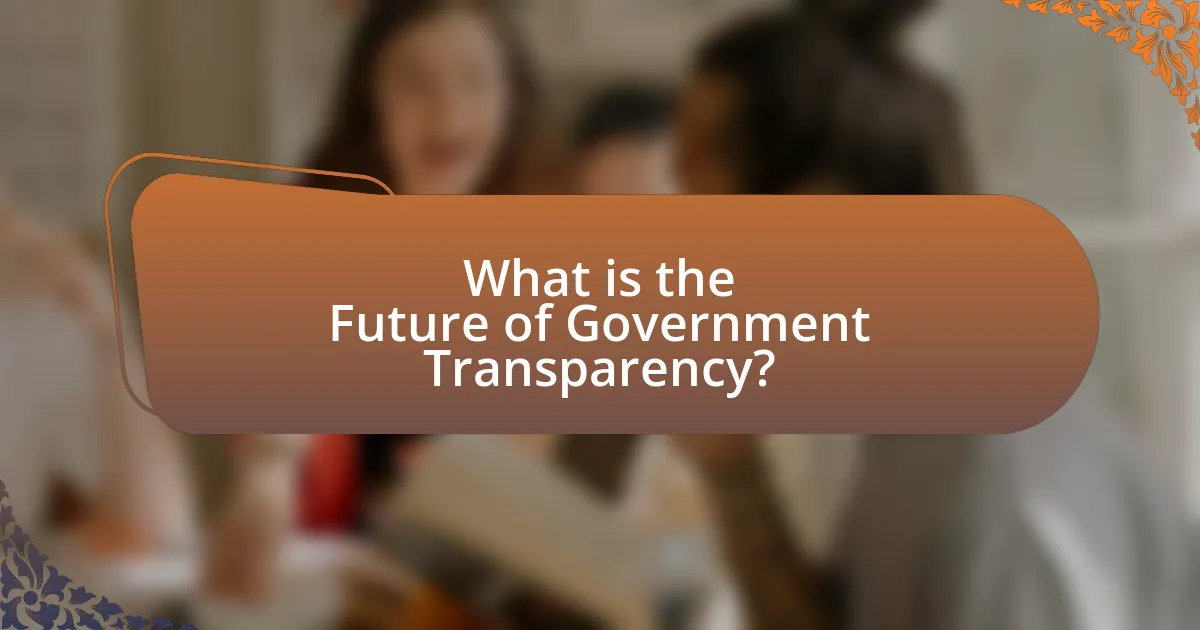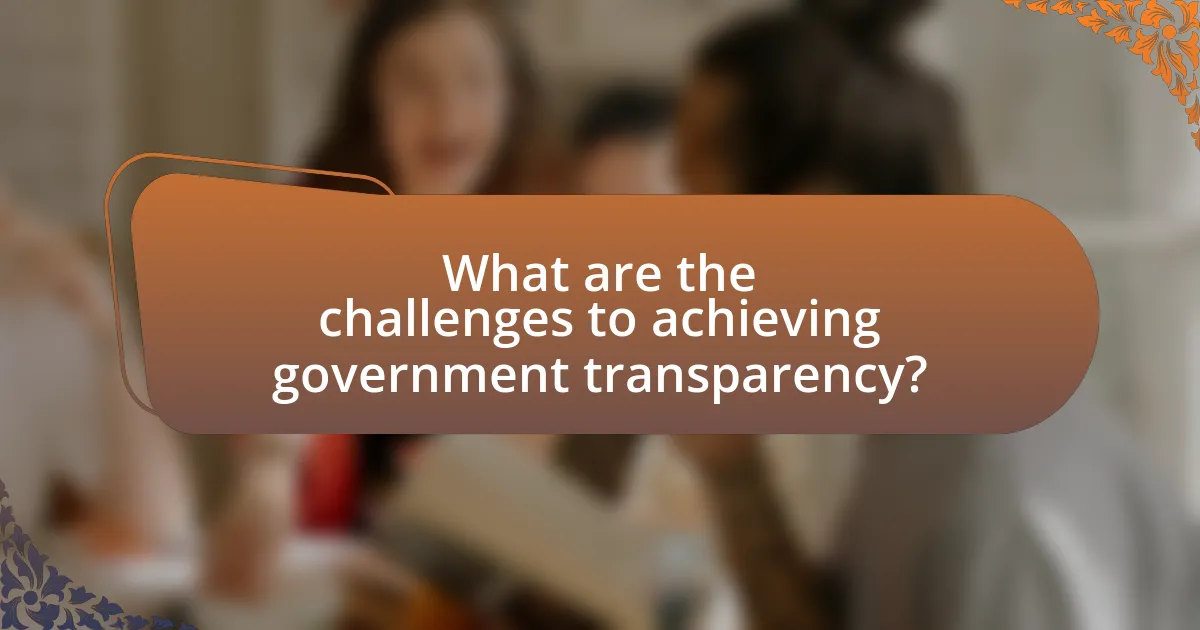The article examines the future of government transparency, emphasizing the role of technology and historical events in shaping current practices. It highlights the evolution of transparency from secrecy to openness, driven by initiatives like the Freedom of Information Act and platforms such as Data.gov. The discussion includes the impact of cultural attitudes on transparency, the importance of accountability in democracy, and the lessons learned from past government cover-ups. Additionally, it addresses the challenges to achieving transparency, the influence of misinformation, and strategies for citizens to advocate for greater openness in governance.

What is the Future of Government Transparency?
The future of government transparency is likely to be characterized by increased digital access and real-time data sharing. As technology advances, governments are adopting open data initiatives, which allow citizens to access information about government activities and decisions more easily. For instance, the U.S. government’s Data.gov platform provides public access to a vast array of datasets, promoting accountability and informed citizen engagement. Additionally, the rise of blockchain technology offers potential for immutable records, enhancing trust in government processes. Studies indicate that transparency correlates with reduced corruption and improved public trust, suggesting that as governments embrace these technologies, they may foster a more open and accountable governance model.
How has government transparency evolved over time?
Government transparency has evolved significantly from the early 20th century to the present day, transitioning from a largely opaque system to one that increasingly values openness and accountability. Initially, government operations were shrouded in secrecy, with limited public access to information. The Freedom of Information Act (FOIA) enacted in the United States in 1966 marked a pivotal moment, allowing citizens to request access to federal agency records, thereby promoting transparency. Over the decades, advancements in technology, particularly the internet, have further enhanced transparency by enabling real-time access to government data and documents. For instance, platforms like data.gov launched in 2009 provide public access to a vast array of government datasets. This evolution reflects a growing recognition of the importance of transparency in fostering trust and accountability in government, as evidenced by numerous studies linking transparency to reduced corruption and improved public engagement.
What historical events have shaped current transparency practices?
The Watergate scandal significantly shaped current transparency practices by highlighting the need for accountability in government. This event, which involved a break-in at the Democratic National Committee headquarters and subsequent cover-up by the Nixon administration, led to widespread public distrust in government officials. The fallout resulted in the establishment of the Freedom of Information Act amendments in 1974, which aimed to enhance public access to government records. Additionally, the Pentagon Papers case in 1971 underscored the importance of transparency in government actions, as it revealed the extent of U.S. involvement in Vietnam, prompting calls for greater openness. These historical events collectively influenced the development of modern transparency practices, emphasizing the necessity for governmental accountability and public access to information.
How do cultural attitudes influence government transparency?
Cultural attitudes significantly influence government transparency by shaping public expectations and norms regarding accountability and openness. In societies where trust in government is high, citizens are more likely to demand transparency and engage in oversight, leading to more open governance practices. For instance, countries like Sweden and Denmark, which have strong cultural norms favoring transparency, consistently rank high on transparency indices, such as the Transparency International Corruption Perceptions Index. Conversely, in cultures where skepticism towards government is prevalent, such as in some authoritarian regimes, there is often a lack of demand for transparency, resulting in opaque governance and limited public access to information. This relationship illustrates how cultural values directly impact the mechanisms and effectiveness of government transparency initiatives.
Why is government transparency important for democracy?
Government transparency is crucial for democracy because it fosters accountability and trust between citizens and their government. When governments operate transparently, they allow citizens to access information about decision-making processes, expenditures, and policies, which empowers the public to hold officials accountable for their actions. For instance, studies have shown that countries with higher levels of transparency, such as Sweden and Denmark, tend to have lower levels of corruption and higher public trust in government institutions. This correlation underscores the importance of transparency in promoting an informed electorate, which is essential for the functioning of a healthy democracy.
What role does transparency play in public trust?
Transparency is crucial for building and maintaining public trust. When governments and organizations operate transparently, they provide clear information about their actions, decisions, and processes, which fosters accountability. Research indicates that higher levels of transparency correlate with increased public confidence; for instance, a study by the World Bank found that transparency in government operations can lead to improved citizen trust and engagement. This relationship is evident in cases where transparency has mitigated scandals or cover-ups, demonstrating that openness can restore faith in institutions.
How does transparency affect citizen engagement?
Transparency significantly enhances citizen engagement by fostering trust and accountability between the government and the public. When citizens have access to clear and open information regarding government actions and decisions, they are more likely to participate in civic activities, such as voting and public discussions. Research conducted by the World Bank indicates that increased transparency can lead to a 20% rise in citizen participation in governance processes. This correlation demonstrates that when citizens feel informed and empowered, they are more inclined to engage actively with their government, ultimately leading to improved democratic outcomes.

What lessons can be learned from past cover-ups?
Past cover-ups reveal critical lessons about the importance of transparency and accountability in governance. Historical examples, such as the Watergate scandal, demonstrate that attempts to conceal information can lead to significant political fallout and loss of public trust. The Watergate incident resulted in the resignation of President Nixon and highlighted the necessity for checks and balances within government institutions. Furthermore, the exposure of the Tuskegee Syphilis Study illustrates the ethical implications of withholding information from affected populations, emphasizing the need for informed consent and ethical standards in research and public health. These instances underscore that transparency fosters trust, while cover-ups can lead to long-term damage to institutional credibility and public confidence.
What are some notable government cover-ups in history?
Notable government cover-ups in history include the Watergate scandal, the Tuskegee syphilis study, and the Iran-Contra affair. The Watergate scandal involved a break-in at the Democratic National Committee headquarters and subsequent efforts by President Nixon’s administration to cover up its involvement, leading to Nixon’s resignation in 1974. The Tuskegee syphilis study, conducted by the U.S. Public Health Service from 1932 to 1972, involved the unethical treatment of African American men who were misled about their health status and denied treatment for syphilis. The Iran-Contra affair, which occurred during the Reagan administration in the 1980s, involved the secret sale of arms to Iran to fund Contra rebels in Nicaragua, circumventing Congress’s prohibition on such funding. Each of these events highlights significant failures in government transparency and accountability.
How did these cover-ups impact public perception of government?
Cover-ups significantly eroded public trust in government institutions. Historical instances, such as the Watergate scandal, revealed governmental misconduct, leading to widespread skepticism about the integrity and transparency of elected officials. According to a Gallup poll conducted in 1974, public confidence in the presidency dropped to 26% following the revelations, illustrating a direct correlation between cover-ups and diminished trust. This decline in trust has persisted, as subsequent cover-ups, like the Iran-Contra affair and more recent events, have reinforced the perception that governments often prioritize self-preservation over accountability, further alienating citizens from their leaders.
What were the consequences for officials involved in these cover-ups?
Officials involved in cover-ups often faced severe consequences, including legal action, loss of employment, and damage to their reputations. For instance, in the Watergate scandal, key officials resigned or were fired, and several were prosecuted, leading to convictions and prison sentences. Similarly, in the case of the Flint water crisis, officials faced criminal charges, resulting in jail time for some. These outcomes highlight the accountability mechanisms that can be triggered by such misconduct, reinforcing the importance of transparency in government operations.
How can past cover-ups inform future transparency efforts?
Past cover-ups can inform future transparency efforts by highlighting the consequences of secrecy and the importance of accountability. Historical instances, such as the Watergate scandal, demonstrate that lack of transparency can lead to public distrust and significant political fallout. This event revealed the necessity for robust checks and balances, prompting reforms like the Freedom of Information Act, which aims to enhance governmental accountability. By analyzing these past failures, future transparency initiatives can be designed to prioritize open communication, establish clear reporting mechanisms, and foster a culture of honesty within organizations, ultimately preventing similar cover-ups and restoring public trust.
What strategies can be implemented to prevent future cover-ups?
Implementing robust whistleblower protections is a key strategy to prevent future cover-ups. By ensuring that individuals who report misconduct can do so without fear of retaliation, organizations can foster a culture of transparency. Historical examples, such as the Sarbanes-Oxley Act of 2002, demonstrate that strong legal frameworks for whistleblower protection can lead to increased reporting of unethical behavior, thereby reducing the likelihood of cover-ups. Additionally, regular audits and independent oversight can serve as deterrents, as seen in various governmental reforms following scandals, which have shown that accountability mechanisms are effective in promoting transparency and preventing misconduct.
How can technology enhance transparency in government?
Technology can enhance transparency in government by facilitating real-time access to information and enabling citizen engagement. Digital platforms, such as open data portals and e-governance applications, allow citizens to access government data, budgets, and decision-making processes easily. For instance, the U.S. government’s Data.gov initiative provides public access to a vast array of government datasets, promoting accountability and informed public discourse. Additionally, blockchain technology can ensure the integrity of public records, making it difficult to alter information without detection. Studies have shown that governments employing technology for transparency see increased public trust and participation, as evidenced by the World Bank’s report on the impact of open data initiatives in various countries.

What are the challenges to achieving government transparency?
Achieving government transparency faces several challenges, including bureaucratic resistance, lack of public awareness, and inadequate legal frameworks. Bureaucratic resistance often stems from a culture of secrecy within government institutions, where officials may fear accountability or exposure of misconduct. Lack of public awareness can hinder transparency efforts, as citizens may not demand information or engage with government processes. Additionally, inadequate legal frameworks can limit access to information, as laws governing transparency may be weak or poorly enforced, resulting in insufficient mechanisms for accountability. These challenges collectively impede the progress toward a more transparent government.
What obstacles do governments face in increasing transparency?
Governments face several obstacles in increasing transparency, including bureaucratic resistance, political interests, and public mistrust. Bureaucratic resistance often stems from entrenched practices and a culture that prioritizes information control over openness. Political interests can lead to the withholding of information that may be damaging to those in power, as seen in various historical cover-ups. Additionally, public mistrust can hinder transparency efforts, as citizens may doubt the authenticity of the information provided, leading to skepticism about government intentions. These factors collectively create a challenging environment for enhancing transparency in governance.
How do political interests hinder transparency initiatives?
Political interests hinder transparency initiatives by prioritizing the protection of power and influence over the dissemination of information. When political entities perceive transparency as a threat to their authority or agenda, they may implement policies that restrict access to information, manipulate data, or engage in cover-ups. For instance, during the Watergate scandal, political leaders obstructed investigations to maintain their positions, illustrating how vested interests can compromise accountability and public trust. Such actions create an environment where transparency is undermined, ultimately eroding democratic principles and citizen engagement.
What role does misinformation play in transparency challenges?
Misinformation significantly undermines transparency challenges by obscuring the truth and creating confusion among the public. When false information spreads, it can lead to distrust in legitimate sources, making it difficult for citizens to discern accurate information from misleading narratives. For instance, during the COVID-19 pandemic, misinformation about the virus and vaccines proliferated, complicating public health communication and eroding trust in health authorities. This illustrates how misinformation can create barriers to transparency, as it diverts attention from factual reporting and hinders informed decision-making.
How can citizens advocate for greater transparency?
Citizens can advocate for greater transparency by actively participating in local governance, utilizing tools such as public records requests, and engaging in community organizing. By attending town hall meetings and voicing concerns, citizens can hold officials accountable. Public records requests, supported by laws like the Freedom of Information Act, empower citizens to access government documents, revealing information that may otherwise remain hidden. Additionally, organizing campaigns or coalitions focused on transparency issues can amplify citizen voices, as seen in movements that successfully pushed for open data initiatives in various cities. These actions collectively foster a culture of accountability and openness in government.
What tools and resources are available for citizens to promote transparency?
Citizens can promote transparency through various tools and resources, including open data platforms, transparency advocacy organizations, and public records requests. Open data platforms, such as Data.gov, provide access to government datasets, enabling citizens to analyze and scrutinize information. Transparency advocacy organizations, like the Sunlight Foundation, offer resources, training, and support for civic engagement in government accountability. Public records requests, facilitated by laws such as the Freedom of Information Act, empower citizens to obtain government documents and information, fostering greater accountability and transparency in governance.
How can grassroots movements influence government transparency policies?
Grassroots movements can influence government transparency policies by mobilizing public support, raising awareness, and advocating for accountability. These movements often utilize social media and community organizing to highlight issues of corruption or lack of transparency, thereby pressuring government officials to adopt more open practices. For instance, the Transparency International organization has shown that grassroots campaigns can lead to significant policy changes, as seen in various countries where public demand for transparency has resulted in the implementation of freedom of information laws. Such movements create a collective voice that can compel governments to prioritize transparency, ultimately fostering a culture of accountability and trust.
What best practices can be adopted for enhancing government transparency?
To enhance government transparency, adopting practices such as proactive disclosure of information, implementing open data initiatives, and fostering public engagement is essential. Proactive disclosure involves making information available without the need for requests, which can significantly reduce information asymmetry. Open data initiatives, where government data is made accessible in machine-readable formats, empower citizens and promote accountability. Additionally, fostering public engagement through forums and consultations allows citizens to participate in decision-making processes, thereby increasing trust and transparency. These practices are supported by studies indicating that transparency leads to improved governance and reduced corruption, as evidenced by the World Bank’s findings on the positive correlation between transparency and public trust.
